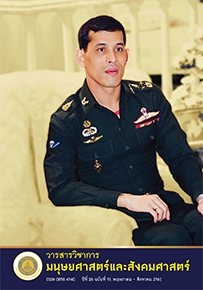การแก้กรรมในพุทธปรัชญาเถรวาท Kamma Rectification in Theravada Buddhist Philosophy
Main Article Content
Abstract
The purpose of this thesis is (1) to study the concept of Kamma and Kamma Rectification in Theravada Buddhist Philosophy and (2) to criticize the concept of the Kamma Rectification in Thailand. This thesis is the qualitative thesis conducted by researching the information from the important sacred books of Buddhism including Tripitaka (Buddhist Scriptures), exegesis and related books, journal, articles and theses. The findings of the research reveal that “Kamma” in Buddhism means the action that is caused by the intention, and then it is expressed physically and mentally. Its effects depend on Kamma’s deeds or power. This causes us to be reincarnated as our life is full of desire and we can get rid of the desire by following the Noble Eightfold Path. In Thai culture Thai people relieve their worries by making merit, donating to the temple, joining the religious ceremony, going to a meditation retreat, paying homage to the gods and goddesses, praying and even visiting mediums who can communicate with persons with previous deeds on each other, and etc. This concept of Kamma in Thai society is both contradictory and consistent with the “Kamma” in Buddhist doctrines in which there is the belief that our lives were destined by previous Kamma and gods. Therefore, people make merit after the Buddhist doctrines. However, they still believe in Kamma rectification. In fact, the Kamma rectification by making merit hasn’t been contradictory with the Kamma in Buddhist doctrines in which current good Kamma can rectify the previous bad Kamma, and such a belief was shown in the exegesis.
Downloads
Article Details
บทความทุกบทความเป็นลิขสิทธิ์ของวารสารวิชาการมนุษยศาสตร์และสังคมศาสตร์ มหาวิทยาลัยบูรพาเท่านั้น
References
มหาจุฬาลงกรณราชวิทยาลัย. (2539). พระไตรปิฎกภาษาไทย ฉบับมหาจุฬาลงกรณราชวิทยาลัย เล่มที่ 18. กรุงเทพฯ: โรงพิมพ์ มหาจุฬาลงกรณราชวิทยาลัย.
มหาจุฬาลงกรณราชวิทยาลัย. (2539). พระไตรปิฎกภาษาไทย ฉบับมหาจุฬาลงกรณราชวิทยาลัย เล่มที่ 20. กรุงเทพฯ: โรงพิมพ์ มหาจุฬาลงกรณราชวิทยาลัย.
มหาจุฬาลงกรณราชวิทยาลัย. (2539). พระไตรปิฎกภาษาไทย ฉบับมหาจุฬาลงกรณราชวิทยาลัย เล่มที่ 22. กรุงเทพฯ: โรงพิมพ์ มหาจุฬาลงกรณราชวิทยาลัย.
มหามกุฎราชวิทยาลัย. (2537). พระไตรปิฎกและอรรถกถาแปล ฉบับมหามกุฎราชวิทยาลัย ชุด 91 เล่ม. กรุงเทพฯ: โรงพิมพ์ มหามกุฎราชวิทยาลัย.
พระพรหมคุณาภรณ์ (ป.อ. ปยุตฺโต). (2549). ปฏิกรรม (ตอนที่2) คนที่แก้กรรมจะงอกงามก้าวหน้า. วันที่สืบค้นข้อมูล14 ธันวาคม
2559, จาก https://www.openbase.in.th/node/6803.
พระพรหมคุณาภรณ์ (ป.อ. ปยุตฺโต). (2553). พจนานุกรมพุทธศาสน์ ฉบับประมวลธรรม (พิมพ์ครั้งที่ 18). นนทบุรี: โรงพิมพ์
เพิ่มทรัพย์การพิมพ์.
พระพรหมคุณาภรณ์ (ป.อ. ปยุตฺโต). (2557). เชื่อกรรม-รู้กรรม-แก้กรรม (พิมพ์ครั้งที่ 42). นครปฐม: บริษัท จ.เจริญ อินเตอร์พริ้น (ประเทศไทยจำกัด) จำกัด.
พระไพศาล วิสาโล (2552). เชื่อกรรมอย่างไรไม่ให้ตกต่ำ (ออนไลน์). วันที่สืบค้นข้อมูล 29 มีนาคม 2560, จาก https://www.budnet.org/article/?p=221.
พจนานุกรมธรรมของท่านพุทธทาส. (ม.ป.ป.). กรุงเทพฯ: ธรรมสภาและสถาบันบันลือธรรม.
วีระวัฒน์ ชลสวัสดิ์. (2559). แก้กรรม ตามคำพระพุทธเจ้า. กรุงเทพฯ: สำนักพิมพ์ กรีน ปัญญาญาณ.
สุชาดา วสุธาร. (2553). ความเชื่อเรื่องการแก้กรรมในสังคมไทยปัจจุบัน. วิทยานิพนธ์ศิลปะศาสตรมหาบัณฑิต. สาขาวิชา
พุทธศาสน์ศึกษา, คณะอักษรศาสตร์, จุฬาลงกรณ์มหาวิทยาลัย.
อำนาจ ยอดทอง. (2557). “การแก้กรรม” ตามนัยคัมภีร์พระพุทธศาสนา. วารสารสมาคมปรัชญาและศาสนาแห่งประเทศไทย,9 (2),
1-44.
“หมอปลา” แนะวิธีกรวดน้ำที่ถูกต้อง ควรกรวดให้ตัวเองก่อน เพื่อเป็นกำแพงบุญ. (2560). วันที่สืบค้นข้อมูล 31 สิงหาคม 2560, จาก
https://horoscope.sanook.com/113493/.


